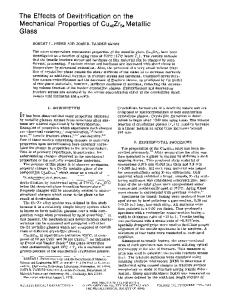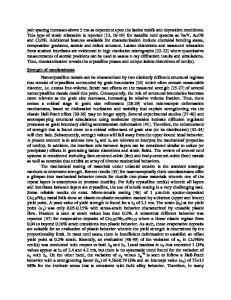The effects of the mechanical properties of the confinement material on electromigration in metallic interconnects
- PDF / 190,950 Bytes
- 6 Pages / 612 x 792 pts (letter) Page_size
- 67 Downloads / 321 Views
New low-dielectric-constant interlevel dielectrics are being investigated as alternatives to SiO2 for future integrated circuits. In general, these materials have very different mechanical properties from SiO2. In the standard model, electromigration-induced stress evolution caused by changes in the number of available lattice sites in interconnects is described by an effective elastic modulus, B. Finite element calculations were carried out to obtain B as a function of differences in the modulus, E, of interlevel dielectrics, for several stress-free homogeneous dilational strain configurations, for several line aspect ratios, and for different metallization schemes. In contradiction to earlier models, we found that for Cu-based metallization schemes with liners, a decrease in E by nearly two orders of magnitude has a relatively small effect on B, changing it by less than a factor of 2. However, B, and therefore the reliability of Cu interconnects, can be strongly dependent on the modulus and thickness of the liner material.
I. INTRODUCTION
Electromigration continues to be one of the most important reliability issues for integrated circuit metallization systems.1 Extensive experimental and theoretical studies have been carried out leading to an in-depth understanding of electromigration and electromigrationinduced phenomena. Computer simulations, which are often based on the Korhonen model for electromigration,2 provide important and efficient tools for understanding and predicting the kinetics of electromigration.3,4 The Korhonen model was originally developed for SiO2-embedded Al-based metallization systems for which grain boundaries provide the fastest diffusion paths for electromigration.5 However, the increase in the ratio of the wiring delay to the intrinsic transistor delay has provided the motivation for the integrated circuit industry to move from aluminum-based interconnects embedded in SiO2 to copper-based metallization systems with interlevel dielectrics (ILDs) having lower dielectric constants, k, than SiO2.6 The Korhonen model for electromigration cannot be applied to Cu-based metallization systems without modifications. For example, electromigration experiments on Cu interconnects have shown that diffusion takes place primarily along the Cu/passivation interface, regardless of the grain-boundary structure.7 In addition, low-k ILDs are often polymer based, and are
a)
Present address: Intel Corporation, Hillsboro, Oregon 97124. J. Mater. Res., Vol. 15, No. 8, Aug 2000
http://journals.cambridge.org
Downloaded: 19 Mar 2015
mechanically much softer than SiO2.8 Typical examples of polymer-based ILDs are fluorinated poly(arylene ether) (FLARE), 9 SiLK, 10 and polyimide 11 , all of which have Young’s moduli that are more than an order of magnitude smaller than that of SiO2. In this paper, we report on studies of the effects of changing the mechanical properties of the ILD along with changes of line aspect ratio and the presence of liner or barrier materials on the electromigration behavior of Cu inter
Data Loading...











